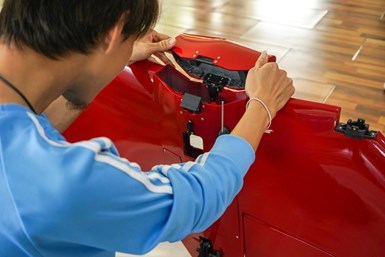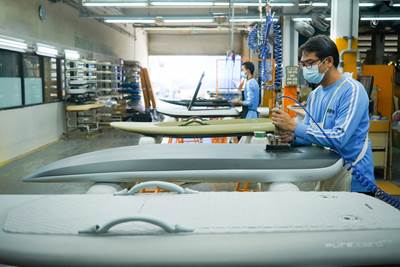Cobra supports new production concept for composites-intensive VETAL tailsitter drone
Cost-effective composite tooling and a scaled-up production line target durability, production rate and price parameters for the VETAL’s carbon fiber flying wing airframe.

All photo credit: Cobra International, HG Robotics
Cobra International (Chonburi, Thailand) has expanded its development and manufacturing partnership with Thai unmanned aerial vehicle (UAV) producer HG Robotics (Bangkok). In this latest collaboration, Cobra has supported HG Robotics with the development of an entirely new production concept for the carbon fiber composite flying wing of the “VETAL” vertical take-off and landing (VTOL) drone.
VETAL is a twin rotor, tailsitting drone that HG Robotics has recently launched for large-scale agricultural surveys, as well as general surveillance monitoring. Cobra reports that it has been working with HG Robotics since 2018 to design and produce its composite components.
Having developed VETAL platform’s initial flying shape, HG Robotics had initially produced the first flying prototypes using a more traditional UAV construction technique of thin composite skins, with ribs and frames supporting the hollow structure. However, although these early aircraft performed well in flight, there were concerns that the construction approach used would not be able to meet all the project requirements relating to durability, production rate and price.
Drawing from its decades of experience with close-tolerance molding of EPS foam-cored sandwich components for the watersports market, Cobra proposed a hybrid solution, combining both hollow and cored sections, for the flying wing. The main body of the aircraft comprises a PVC foam sandwich shell with a low-density EPS foam rib which, combined with a fully foam cored tail structure, is said to deliver a complete airframe fractionally lighter than the customer’s challenging target.
In addition to an impressive cycle time reduction, the new build method also improved the impact resistance and overall durability of the VETAL platform, a key benefit for industrial users who need survey drones with minimum maintenance.

To reduce weight, a combination of carbon fiber stitched biaxial fabrics and unidirectional (UD) reinforcements are used wherever possible, Cobra says, with additional glass fiber-reinforced laminate sections being employed where radio transparency or insulation from metallic parts is required.
The Cobra production engineers have also been able to incorporate glass fiber reinforcements and mounting points for the VETAL’s propulsion system and other ancillary equipment into the molding process, minimizing the additional processing steps in the assembly and finishing stages.
Currently, cost-effective composite tooling has been produced for the first Cobra-built VETAL airframes, enabling a rapid start-up to the series production, while still providing the possibility for incremental design changes before switching to CNC-machined aluminum tooling for high-rate production in the future. With process parameters defined in line with the company’s lean manufacturing principles, Cobra has prepared a production line that can scale up quickly. HG Robotics has also successfully developed an extensive client base for its previous multi-rotor drones and Cobra expects to see considerable demand for the new VETAL platform for larger scale survey applications.
“We are pleased to be strengthening our relationship with HG Robotics and working together on the VETAL project,” says Sila Sertsorn, technical director, Cobra International. “It is a great example of how Cobra can develop durable, reliable and affordable composite components and manufacture on a mass production scale. Our customers are exceptional product designers, and we provide the complimentary skills to incorporate the most efficient composite materials and processes.”
Related Content
ATLAM combines composite tape laying, large-scale thermoplastic 3D printing in one printhead
CEAD, GKN Aerospace Deutschland and TU Munich enable additive manufacturing of large composite tools and parts with low CTE and high mechanical properties.
Read MoreASCEND program update: Designing next-gen, high-rate auto and aerospace composites
GKN Aerospace, McLaren Automotive and U.K.-based partners share goals and progress aiming at high-rate, Industry 4.0-enabled, sustainable materials and processes.
Read MorePlant tour: BeSpline/Addcomp, Sherbrooke, QC, Canada
Composites automation specialist increases access to next-gen technologies, including novel AFP systems and unique 3D parts using adaptive molds.
Read MoreOptimizing a thermoplastic composite helicopter door hinge
9T Labs used Additive Fusion Technology to iterate CFRTP designs, fully exploit continuous fiber printing and outperform stainless steel and black metal designs in failure load and weight.
Read MoreRead Next
Cobra International supports composite electric hydrofoil board evolution
Cobra continues to deliver materials, production process support, as well as manufacture Fliteboard’s carbon fiber Fliteboard Series 2 surfboards.
Read MorePlant tour: Daher Shap’in TechCenter and composites production plant, Saint-Aignan-de-Grandlieu, France
Co-located R&D and production advance OOA thermosets, thermoplastics, welding, recycling and digital technologies for faster processing and certification of lighter, more sustainable composites.
Read MoreVIDEO: High-volume processing for fiberglass components
Cannon Ergos, a company specializing in high-ton presses and equipment for composites fabrication and plastics processing, displayed automotive and industrial components at CAMX 2024.
Read More












.jpg;maxWidth=300;quality=90)












